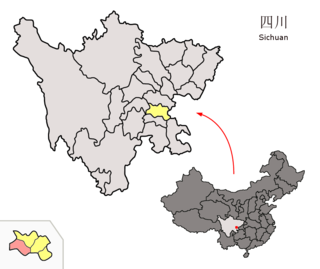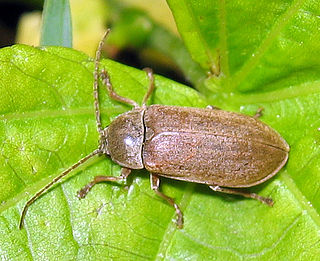The Shanwang National Geology Park is located in central Shandong province, People's Republic of China, about 22 kilometres (14 mi) from Linqu County. It has an area of about 13 square kilometres (5.0 sq mi). The Park is well known for the fossil bearing Shanwang Formations diatomitic deposits, one of only a few such deposits in China. It is also well known for its volcanic topography.

Weiyuan County is a county of Sichuan Province, China. It is under the administration of Neijiang City. The county borders Neijiang, Zigong, Rongxian, Zizhong and Renshou. It administers 20 townships.
Bagongshan is a district of the city of Huainan, Anhui Province, China.

Xishui County is a county in the north of Guizhou province, China, bordering Sichuan province to the southwest. It is under the administration of the prefecture-level city of Zunyi.

Ursavus is an extinct genus of bear that existed in North America, Europe, and Asia during the Miocene period, about 23–5.3 million years ago (Mya), existing for roughly 17.7 million years. The genus apparently dispersed from Asia into North America about 20 Mya, becoming the earliest member of the subfamily Ursinae in the New World. Qiu points out that if a questionable 29 million-year-old specimen of Ursavus reported in North America is validated, Ursavus may have evolved in North America and dispersed westward into Asia. The higher number of fossils in Europe grading toward eastern Asia make the westward dispersal unlikely.

Corixa is a genus of aquatic bugs in the family Corixidae. The fossil species C. elegans is from the Rott Formation in Nordrhein-Westfalen.
Alloiomma is an extinct genus of ants that once belonged to the subfamily Dolichoderinae. A. changweiensis was the first extinct species to be discovered by Zhang in 1989, and another fossil species was discovered in 1994, known as A.differentialis. The ants were endemic to China.
Elaphrodites is an extinct genus of ants of the subfamily Dolichoderinae. Two fossils were discovered and described by Zhang in 1989.
Eurymyrmex is an extinct genus of ant in the Formicidae subfamily Dolichoderinae. The genus contains a single described species Eurymyrmex geologicus. It was described in 1994, where the first fossils of the ant were found in China.
Myopopone sinensis is an extinct species of ant in the genus Myopopone. Fossils were discovered in 1989 in China, and was later described by Zhang in that year.
Dolichoderus jiaoyanshanensis is an extinct species of ant in the genus Dolichoderus. Fossils containing the species were found in China, and it was described by Hong in 1985. The ant is from Shanwang and is presumed to be a Miocene insect.
Dolichoderus lacinius is an extinct species of Miocene ant in the genus Dolichoderus. Described by Zhang in 1989, fossils of a queen specimen were found in China.
Dolichoderus luridivenosus is an extinct species of Miocene ant in the genus Dolichoderus. Described by Zhang, Sun and Zhang in 1994, the species was discovered after a fossil of a queen was found in China.
Dolichoderus transversipetiolaris is an extinct species of Miocene ant in the genus Dolichoderus. Described by Zhang, Sun and Zhang in 1994, the species was discovered after a fossil of a queen was found in China.
Liometopum eremicum is an extinct species of Miocene ant in the genus Liometopum. Described by Zhang in 1989, the fossils were found in China.
Liometopum lubricum is an extinct species of Miocene ant in the genus Liometopum. Described by Zhang, Sun and Zhang 1994, the fossils were found in China.
Liometopum potamophilum is an extinct species of Miocene ant in the genus Liometopum. Described by Zhang in 1989, the fossils were found in China.
Tapinoma baculum is an extinct species of ant in the genus Tapinoma. Described by Zhang in 1989, fossils of the species were found in China.
Sinapriculus was an extinct genus of even-toed ungulates that existed in China during the Miocene.

Dascillidae is a family of beetles within the clade Elateriformia. There are about 100 extant species in 11 genera, which are found worldwide. Dascillidae together with Rhipiceridae form the super family Dascilloidea.




